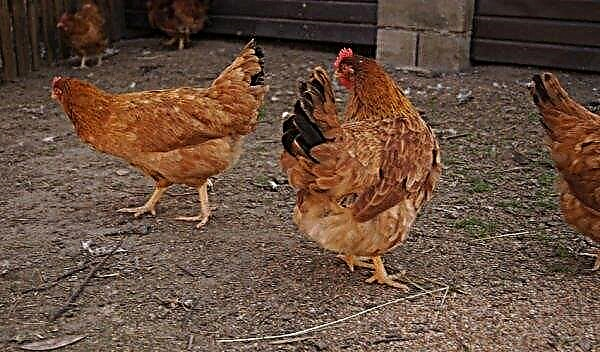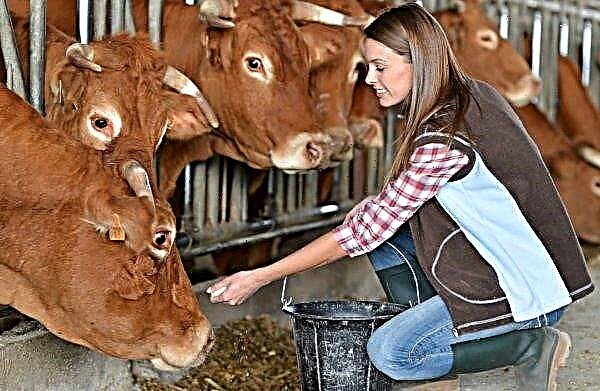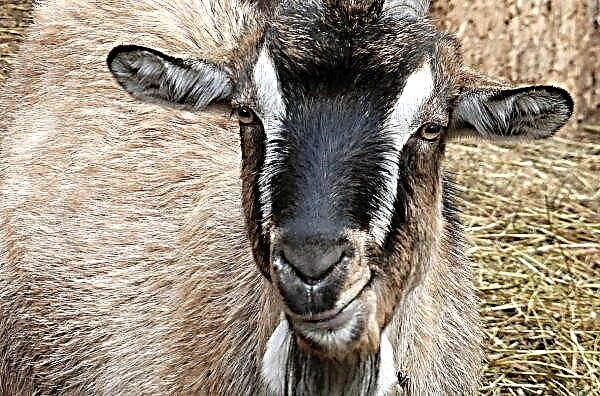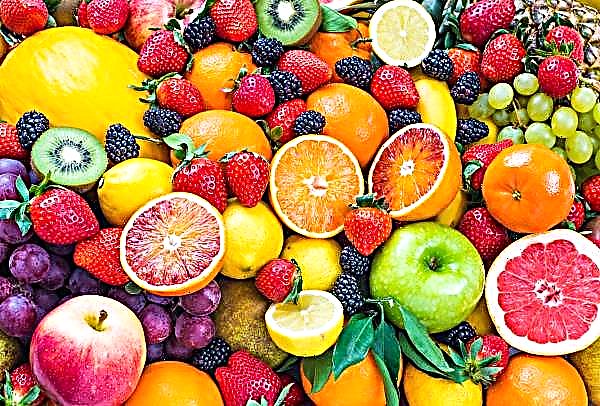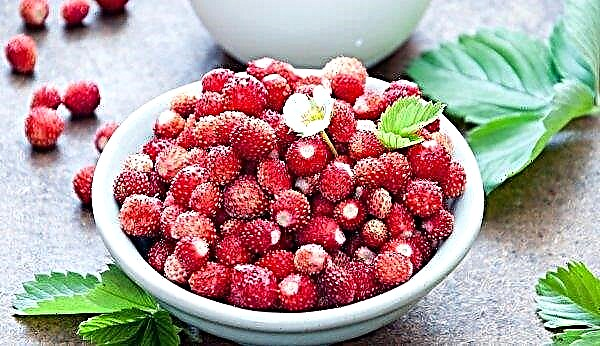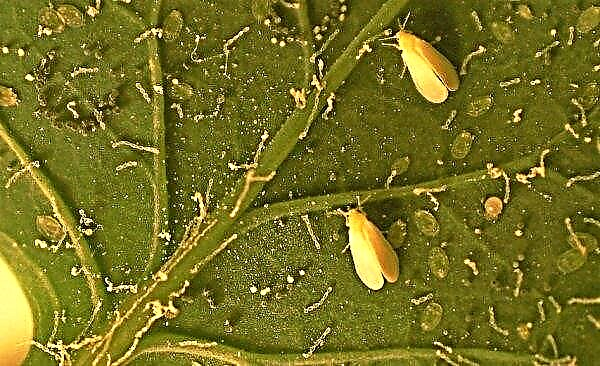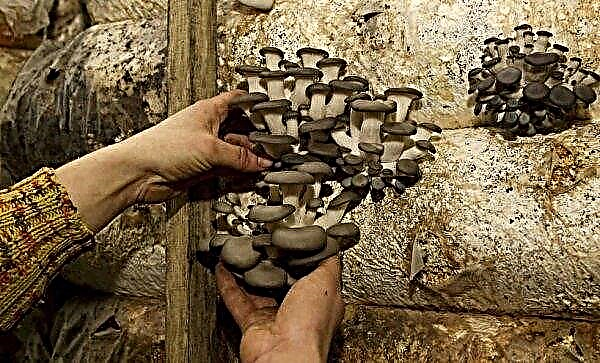Cabbage is one of the most beloved, most common and most wholesome vegetables found in every home. By maturity, it is early, middle and late. One of the representatives of the late varieties is Kolobok f1.
Variety selection and characterization
White cabbage Kolobok f1 was bred by the N. N. Timofeev breeding station, and in 2004 it was entered into the State Register of Breeding Achievements of the Russian Federation. This variety belongs to late-ripening varieties. Heads of cabbage forms dense and juicy, round in shape, weighing up to 4.5 kg.
On top of the head is green, and when the cut is light yellow. The leaf rosette develops in diameter up to 40 cm, in height - up to 35 cm. Cabbage leaves are saturated green in color, smooth with a pronounced wax coating, slightly wavy at the edges. Productivity is 7-12 kg / m².

Advantages and disadvantages
- The positive qualities of cabbage Kolobok f1 include:
- high taste, lack of bitterness;
- universality in use;
- long-term storage;
- excellent presentation;
- well transported over long distances;
- high productivity;
- resistance to certain diseases;
- heads of cabbage do not crack.
Did you know? In ancient Rome, cabbage juice was considered an excellent remedy for intoxication.
- Cons of this grade are:
- high soil requirements;
- need for good lighting.
Self-growing seedlings
The cabbage variety Kolobok f1 is best grown in seedlings, observing the main requirements, which include proper preparation for sowing and seedling care.
The timing
Since this variety is late, it is best to sow the seeds at the beginning or in the middle of April, 50 days before planting in the garden.
Soil selection and preparation
To sow seeds, you must first prepare the soil. You can buy it ready-made in a specialized store, or you can do it yourself by mixing 7 parts of peat, 2 parts of humus, 1 part of turf land, 1 part of mullein. For disinfection, the earth must be treated with a boiled solution of potassium permanganate dark pink in color, then add wood ash and mix.

Capacity selection
You can grow seedlings of cabbage Kolobok f1 in different containers, given their pros and cons.
These include:
- wooden boxes - should be low 8-10 cm, with drainage. Convenient in that all the seedlings are in one place, it is easier to carry and turn to the light, and you can also make them yourself. The downside is that later the seedlings will need to be dive into separate containers, and this injures the plant, which will take longer to take root;
- individual cups - with a capacity of 100-200 ml with drainage holes. The advantage is that they are inexpensive, can be used repeatedly, no need to dive seedlings, do not take up much space. The negative qualities include the fact that the seedlings grow weaker, the earth dries faster, the walls of the cups are soft and when transplanted to a permanent place, the roots of the plant can be damaged;
- peat tablets - with a diameter of 6–8 cm and a height of 10–12 cm. The advantages include the fact that the tablets additionally fertilize the seedlings, the sprouts sprout faster, the plants land with them without damage. The disadvantages are that they are more expensive, they are used only once, and it is necessary to constantly control the moisture content of peat, preventing its drying out or over-moistening.
Seed selection and preparation
When buying seeds, you need to find out whether they went through pre-sowing treatment or not.

If you have passed, then they can be sown immediately in the soil, if not, you need to carry out preparation, namely:
- first you need to dry the seeds at a temperature of +30 ... + 35 ° C for 5-6 days;
- make a selection - immerse the seeds in salt water (3-5 g of salt per 100 ml of warm water) and discard the emerging;
- disinfect in a 1% potassium permanganate solution for 15–20 minutes and rinse;
- wrap the family in a napkin or cheesecloth and soak in the stimulating solution “Epin” (1 drop per 0.5 liter of water), “Nitrofoska” (5 g per 1 liter of water) for 12-15 hours;
- make hardening, which consists in soaking the seed in water heated to + 50 ° C for 20-30 minutes, then place it in a refrigerator and incubate for 24 hours at a temperature of +1 ... + 2 ° C;
- at the end of everything dry again.
Important! With low soil acidity, cabbage seedlings will grow poorly and develop, which will subsequently affect the yield.
Sowing seeds
Sowing the seed of cabbage Kolobok f1 requires the following actions:
- Before sowing seeds, the soil must be moistened.
- Make indentations or furrows with a depth of 1 cm.
- Sow 2 seeds in separate cups or tablets (in case one does not germinate) to a depth of 1 cm, leave 3-5 cm distance between seeds in boxes, 2-3 cm between furrows.
- Sprinkle on top with dry earth, slightly compact and pour with a solution of Fitosporin-M (6 g per 10 l of water), Gamair (2 tablets per 10 l of water).
- Cover boxes or other containers with transparent glass or film and put in a warm place with a temperature of + 20 ° С.
- After 4-5 days, when the first shoots appear, lower the temperature to +6 ... + 8 ° C and maintain for a week.
- After the first leaf appears, the seedlings break through.

Seedling Care
When caring for seedlings, you must adhere to some tips, namely:
- picking is done when the seeds are sown in boxes and 2-3 leaves appear on the plant;
- watering should be carried out regularly with warm water, avoiding the drying out of the soil, which should be slightly moist;
- fertilize several times before planting in a permanent place: the first dressing is carried out after 10-14 days with Agricola-1 solution (25 g per 10 liters of water) or mix 10 g of ammonium nitrate, 20 g of superphosphate, 10 g of potassium sulfate with 10 l of water , the second is done 10 days later, the third - 10 days before planting cowberry infusion in open ground (1 tbsp. infusion per 1 liter of water);
- the lighting should be diffused, because from direct sunlight, burns on the leaves may appear. Seedlings must be provided with a 12-hour daylight using a fluorescent lamp or phytolamp;
- at home to keep seedlings best on the windowsill. But it is necessary to protect it from direct sunlight, covering the window with a curtain, and from hot batteries, installing protective shields;
- for good germination of seedlings, the optimum temperature will be + 20 ° C. After germination of the first leaves, the temperature should be reduced by day to +10 ... + 12 ° С, at night - to +6 ... + 8 ° С.
Did you know? It has been proven that cabbage contains substances that slow down the growth of cancer cells.
Seedling hardening
For 7-10 days before planting seedlings on the bed, it must be hardened to strengthen the roots and seedlings to quickly settle in a permanent place.
To do this, you must:
- the first 2 days to open the window for several hours in the room where the seedlings are, avoiding drafts;
- in the next 3 days, bring seedlings to a balcony or veranda for 2-3 hours, covering them with gauze from direct sunlight;
- after that, reduce watering and take out the seedlings on the street until evening, take it back to the room at night;
- on the last day, leave seedlings in the open air until planting;
- immediately before planting, moisten the soil in containers.
Transplanting seedlings to a permanent place
After the preparatory measures are over, you can deal specifically with planting seedlings in open ground.

The timing
For the late-ripening cabbage variety Kolobok f1, the following conditions for planting seedlings at a constant place are suitable:
- the presence of 5-6 adult leaves on a seedling;
- seedling height should be up to 20 cm;
- The optimal transplant period is the end of May;
- air temperature should be from + 17 ° C;
- temperature of the heated soil from + 10 ° С.
Seat selection and crop rotation
An important factor in the cultivation of seedlings is the right place for the future beds:
- the soil should be clay or loamy, well retain moisture;
- the place must be chosen quiet, well-lit so that the seedlings do not stretch, without shading and drafts;
- it is better to plant seedlings after potatoes, peas, beans;
- can not be planted after radish, radish, mustard;
- crop rotation is that after cabbage seedlings can be planted no earlier than 3 years;
- the soil should be close to the groundwater - up to 1.5 m.
Scheme and depth of landing
When planting seedlings in a permanent place, it is necessary to adhere to a distance between plants of 50–70 cm, between rows of 70 cm. Deepen 10–12 cm. Immerse the seedling itself in a hole to the lower leaves.

Cultivation agricultural
Agrotechnical measures include proper watering of plants, tillage, as well as top dressing.
Watering
Watering the cabbage is as follows:
- the first 7 days should be abundantly watered seedlings every day with warm water;
- in the next 7 days, watering, reduce and irrigate the plants after 2-3 days, 0.5–1 l of water per 1 plant;
- the best way to irrigate is sprinkling, so that water is better absorbed into the soil;
- water in the evening when the heat subsides;
- to the extent of the appearance of new leaves, the amount of watering should be increased;
- when the head of cabbage begins to form - maximum watering;
- then gradually reduce so that the heads do not crack;
- 14 days before harvesting, suspend watering.

Soil care
A very important place in the care of cabbage Kolobok f1 is occupied by work in the garden, which includes timely weeding, loosening and hilling of plants:
- the first loosening is done on 8–9 days after planting in a permanent place, when the seedlings fully take root;
- then after each irrigation, the soil must be loosened and at the same time hilled, due to which additional roots appear and the soil is filled with oxygen;
- be sure to weed the beds from weed grass in order to avoid infection with fungal diseases, as well as for better development of seedlings of cabbage.
Fertilizer application
The quality of the crop will depend on how timely and correctly fed the cabbage.
Fertilizing is carried out in several stages:
- first feeding - on the 7th day after planting in open ground with liquid mullein (per 10 liters of water 1 liter of fertilizer), ammonium nitrate (20 g per 10 liters of water);
- in 3 weeks - The second top dressing can also be made with liquid mullein, or you can use chicken droppings (0.5 kg per 10 liters of water) or a solution of wood ash (200 g per 10 liters of water);
- when a head of cabbage develops - the third top dressing is carried out with a mixture of potassium fertilizer, urea and water (10 g of fertilizer per 10 liters of water).
Important! If the soil is wet enough due to heavy rains, then mineral fertilizers can not be planted with water, but sprinkled with them dry on the ground.
When to clean, is it possible to ferment
Cabbage variety Kolobok f1 ripens by the end of September. The heads must be assembled in clear weather at daytime temperatures up to + 4 ° at night to 0 °. This variety can withstand temperatures down to -5 ° C. Since the cut heads of cabbage are less hardy at low temperatures, it is advisable to harvest the crop at a time and put it right away for storage.
Cabbage Kolobok f1, due to the juiciness and density of the leaves, is very suitable for cooking fresh salads, salting, pickling. Even after a long time, it does not lose its taste and has a rich taste.
Among the many late varieties of white cabbage, Kolobok f1 is one of the first places, due to its positive qualities. But in order to get a rich harvest, you must adhere to all the tips outlined above.

